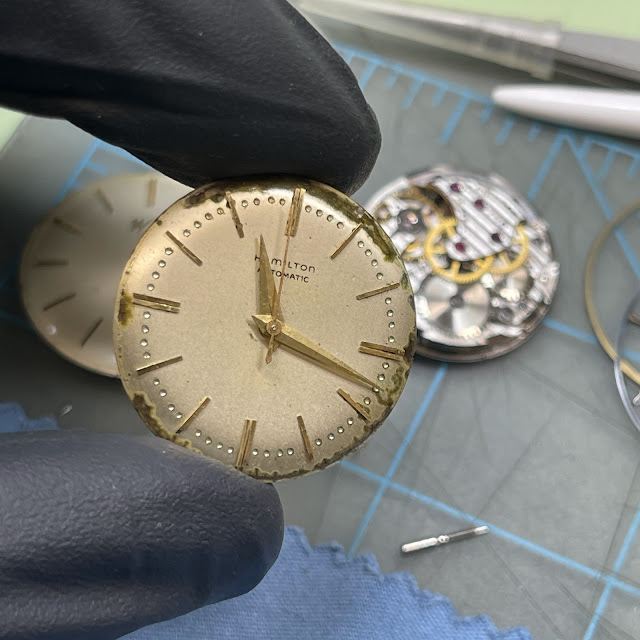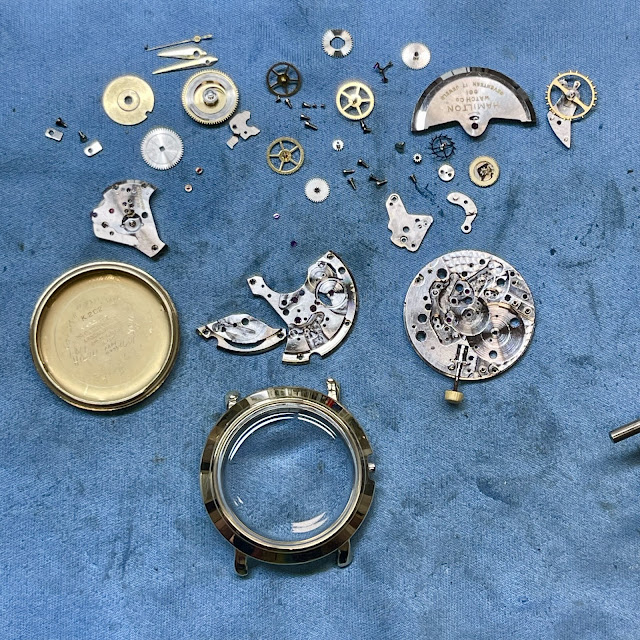One of the frustrating aspects of vintage watches is when you find evidence of a valuable watch getting scrapped. The most obvious evidence is a loose movement and dial for sale.
I don't feel any obligation to save watches from destruction - they're not living beings, after all. However, I feel sad that someone didn't value a valuable watch and poten heirloom.
Almost everyone who contacts me has the same story... "I inherited my father's (grandfather's, great grandfather's, grandmother's, etc) watch and I'd like to learn more about it." I love getting those messages because it shows that watches can convey the connection between generations after an ancestor passes. A vintage watch can be a personal treasure that is priceless to the owner regardless of it's retail value.
When I see a scrapped watch it makes me wonder what sad story is behind it. It's easy to imagine an original owner who had no children, no nephews, perhaps no one at all who cared that they lived or died. Someone received the watch and thought, "I don't care about this thing, I wonder how much I can get for the gold".
It's also possible the recipient is the one with the sad story. Perhaps they fell on hard times and the only thing between them and their next meal was selling grandpa's watch.
Or, worst of all, perhaps the watch was stolen from it's owner and the gold case scrapped for pennies on the dollar. That thought really pisses me off.
So like I said, knowing the value of vintage watches has it's perils.
I was recently asked to take on a very interesting project. It's the opposite of the scenarios above. In this example, the case and dial exists and the rest is missing! This watch belongs to the original owner's son and he wants to restore it so that his own son can inherit it. These are the best of stories and a very worthy cause.
The watch is a Viscount. It was introduced in 1955 and made for four years. It's a popular model and can sell for over $1,500 when it's in great shape!
In 1958 the dial was modified slightly to include a diamond-shaped gold marker added below the Hamilton name. This figure was added to all of the models in the "Masterpiece" line. So if you see this marker you know it's a 1958 example
One of the obvious things that make the Viscount so interesting is the case. The bezel has an open triangular lug that requires the strap to have a V notch to accommodate the spring bar that passed through. It's a very unusual design and that's what makes it so valuable.
My project watch has what appears to be a solid gold bracelet. That's a valuable addition as long as the length works on your wrist. If you look at the dial you will quickly tell that it's rotated 90 degrees. That's simply because there is no movement inside.
What came with the watch is a tiny quartz movement. I wonder what the story is with this watch... why would someone try to outfit it with a quartz movement, especially one without a second hand? Perhaps it just came along for the ride.
The Viscount case is solid 14K gold and other than a slight dent in the back, this example is in pretty good shape.
There are a ton of prior service marks inside the case back. The shape of the opening is a clue that a 12/0 sized movement should be the powerhouse for this model - specifically a 770 movement. The dial has been refinished at some point and the pattern is missing the lines that should crisscross the center. The seconds register should also be a simple cross hair design.
What's more concerning is the dial feet that secure the dial to the movement are gone. So there's nothing to hold this dial down once it's installed. I have a solution for that.
A donor 770 will be the new movement to power this Viscount. This is a 1960's movement based on the glucydur balance but a 770 is a 770. There are no serial numbers to date movements from this era.
Everything is cleaned and ready to be reassembled.
The 770 is arguably the best that Lancaster made when it comes to wrist watch movements. It's a solid design and easy to reassemble.
This movement is running great. I'll leave it just as it is as it should settle down after a little while.
I'll use "dial dots" to hold the dial on. These are tiny two-sided stickers that you apply to the movement and then press the dial on to hold it. They will keep the dial in place and allow a future watchmaker to remove the dial when it needs to be serviced again.
I'll use four dots. All that remains is to pull the beige covers off to reveal the sticky side the dial will attach to.
A new set of hands completes the restoration and with a proper stem and crown this watch is ready for wrist time again. The dial isn't perfect but only a purist would notice or care.

































































